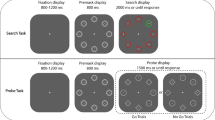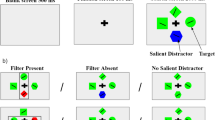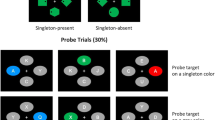Abstract
We are often bombarded with salient stimuli that capture our attention and distract us from our current goals. Decades of research have shown the robust detrimental impacts of salient distractors on search performance and, of late, in leading to altered feature perception. These feature errors can be quite extreme, and thus, undesirable. In search tasks, salient distractors can be suppressed if they appear more frequently in one location, and this learned spatial suppression can lead to reductions in the cost of distraction as measured by reaction time slowing. Can learned spatial suppression also protect against visual feature errors? To investigate this question, participants were cued to report one of four briefly presented colored squares on a color wheel. On two-thirds of trials, a salient distractor appeared around one of the nontarget squares, appearing more frequently in one location over the course of the experiment. Participants' responses were fit to a model estimating performance parameters and compared across conditions. Our results showed that general performance (guessing and precision) improved when the salient distractor appeared in a likely location relative to elsewhere. Critically, feature swap errors (probability of misreporting the color at the salient distractor’s location) were also significantly reduced when the distractor appeared in a likely location, suggesting that learned spatial suppression of a salient distractor helps protect the processing of target features. This study provides evidence that, in addition to helping us avoid salient distractors, suppression likely plays a larger role in helping to prevent distracting information from being encoded.



Similar content being viewed by others
Data availability
Experiment plans and data are available on the Open Science Framework (https://osf.io/gcs4e/).
Code availability
Experimental code is available upon request.
References
Anderson, B. A., Laurent, P. A., & Yantis, S. (2011). Value-driven attentional capture. Proceedings of the National Academy of Sciences, 108(25), 10367–10371. https://doi.org/10.1073/pnas.1104047108
Bays, P. M., Catalao, R. F. G., & Husain, M. (2009). The precision of visual working memory is set by allocation of a shared resource. Journal of Vision, 9(10), 7. https://doi.org/10.1167/9.10.7
Brainard, D. H. (1997). The Psychophysics Toolbox. Spatial Vision, 10(4), 433–436. https://doi.org/10.1163/156856897X00357
Britton, M. K., & Anderson, B. A. (2020). Specificity and persistence of statistical learning in distractor suppression. Journal of Experimental Psychology: Human Perception and Performance, 46(3), 324. https://doi.org/10.1037/xhp0000718
Chang, S., Dube, B., Golomb, J. D., & Leber, A. B. (2023). Learned spatial suppression is not always proactive. Journal of Experimental Psychology. Human Perception and Performance. https://doi.org/10.1037/xhp0001133
Chen, J., Leber, A. B., & Golomb, J. D. (2019). Attentional capture alters feature perception. Journal of Experimental Psychology: Human Perception and Performance, 45(11), 1443–1454. https://doi.org/10.1037/xhp0000681
Darnell, M., & Lamy, D. (2022). Spatial cueing effects do not always index attentional capture: Evidence for a priority accumulation framework. Psychological Research, 86(5), 1547–1564. https://doi.org/10.1007/s00426-021-01597-0
Failing, M., Wang, B., & Theeuwes, J. (2019). Spatial suppression due to statistical regularities is driven by distractor suppression not by target activation. Attention, Perception, & Psychophysics, 81(5), 1405–1414. https://doi.org/10.3758/s13414-019-01704-9
Folk, C. L., Remington, R. W., & Johnston, J. C. (1992). Involuntary covert orienting is contingent on attentional control settings. Journal of Experimental Psychology: Human Perception and Performance, 18(4), 1030–1044. https://doi.org/10.1037/0096-1523.18.4.1030
Gaspelin, N., Leonard, C. J., & Luck, S. J. (2015). Direct Evidence for Active Suppression of Salient-but-Irrelevant Sensory Inputs. Psychological Science, 26(11), 1740–1750. https://doi.org/10.1177/0956797615597913
Gaspelin, N., & Luck, S. J. (2018). Combined Electrophysiological and Behavioral Evidence for the Suppression of Salient Distractors. Journal of Cognitive Neuroscience, 30(9), 1265–1280. https://doi.org/10.1162/jocn_a_01279
Geng, J. J., & Duarte, S. E. (2021). Unresolved issues in distractor suppression: Proactive and reactive mechanisms, implicit learning, and naturalistic distraction. Visual Cognition, 29(9), 608–613. https://doi.org/10.1080/13506285.2021.1928806
Geyer, T., Müller, H. J., & Krummenacher, J. (2008). Expectancies modulate attentional capture by salient color singletons. Vision Research, 48(11), 1315–1326. https://doi.org/10.1016/j.visres.2008.02.006
Gong, D., & Theeuwes, J. (2021). A saliency-specific and dimension-independent mechanism of distractor suppression. Attention, Perception, & Psychophysics, 83(1), 292–307. https://doi.org/10.3758/s13414-020-02142-8
Huang, C., Vilotijević, A., Theeuwes, J., & Donk, M. (2021). Proactive distractor suppression elicited by statistical regularities in visual search. Psychonomic Bulletin & Review, 28(3), 918–927. https://doi.org/10.3758/s13423-021-01891-3
Kleiner, M., Brainard, D. H., & Pelli, D. (2007). What’s new in Psychtoolbox. Perception, 36(14), 1–16.
Kong, S., Li, X., Wang, B., & Theeuwes, J. (2020). Proactively location-based suppression elicited by statistical learning. PLOS ONE, 15(6), e0233544. https://doi.org/10.1371/journal.pone.0233544
Lamy, D., Darnell, M., Levi, A., & Bublil, C. (2018). Testing the Attentional Dwelling Hypothesis of Attentional Capture. Journal of Cognition, 1(1), 43. https://doi.org/10.5334/joc.48
Leber, A. B., Gwinn, R. E., Hong, Y., & O’Toole, R. J. (2016). Implicitly learned suppression of irrelevant spatial locations. Psychonomic Bulletin & Review, 23(6), 1873–1881. https://doi.org/10.3758/s13423-016-1065-y
Lee, M. D., & Wagenmakers, E.-J. (2014). Bayesian Cognitive Modeling: A Practical Course. Cambridge University Press.
Luck, S. J., Gaspelin, N., Folk, C. L., Remington, R. W., & Theeuwes, J. (2021). Progress toward resolving the attentional capture debate. Visual Cognition, 29(1), 1–21. https://doi.org/10.1080/13506285.2020.1848949
Moher, J., & Egeth, H. E. (2012). The ignoring paradox: Cueing distractor features leads first to selection, then to inhibition of to-be-ignored items. Attention, Perception, & Psychophysics, 74(8), 1590–1605. https://doi.org/10.3758/s13414-012-0358-0
Noonan, M. P., Adamian, N., Pike, A., Printzlau, F., Crittenden, B. M., & Stokes, M. G. (2016). Distinct Mechanisms for Distractor Suppression and Target Facilitation. Journal of Neuroscience, 36(6), 1797–1807. https://doi.org/10.1523/JNEUROSCI.2133-15.2016
Pashler, H. (1988). Cross-dimensional interaction and texture segregation. Perception & Psychophysics, 43(4), 307–318. https://doi.org/10.3758/BF03208800
Pelli, D. G. (1997). The VideoToolbox software for visual psychophysics: Transforming numbers into movies. Spatial Vision, 10(4), 437–442.
Rouder, J. N. (2014). Optional stopping: No problem for Bayesians. Psychonomic Bulletin & Review, 21(2), 301–308. https://doi.org/10.3758/s13423-014-0595-4
Sawaki, R., Geng, J. J., & Luck, S. J. (2012). A Common Neural Mechanism for Preventing and Terminating the Allocation of Attention. Journal of Neuroscience, 32(31), 10725–10736. https://doi.org/10.1523/JNEUROSCI.1864-12.2012
Sawaki, R., & Luck, S. J. (2010). Capture versus suppression of attention by salient singletons: Electrophysiological evidence for an automatic attend-to-me signal. Attention, Perception, & Psychophysics, 72(6), 1455–1470. https://doi.org/10.3758/APP.72.6.1455
Schönbrodt, F. D., & Wagenmakers, E.-J. (2018). Bayes factor design analysis: Planning for compelling evidence. Psychonomic Bulletin & Review, 25(1), 128–142. https://doi.org/10.3758/s13423-017-1230-y
Schurgin, M. W., Wixted, J. T., & Brady, T. F. (2020). Psychophysical scaling reveals a unified theory of visual memory strength. Nature Human Behaviour, 4(11), 11. https://doi.org/10.1038/s41562-020-00938-0
Stilwell, B. T., Bahle, B., & Vecera, S. P. (2019). Feature-based statistical regularities of distractors modulate attentional capture. Journal of Experimental Psychology: Human Perception and Performance, 45(3), 419–433. https://doi.org/10.1037/xhp0000613
Suchow, J. W., Brady, T. F., Fougnie, D., & Alvarez, G. A. (2013). Modeling visual working memory with the MemToolbox. Journal of Vision, 13(10), 9. https://doi.org/10.1167/13.10.9
Theeuwes, J. (1994). Stimulus-driven capture and attentional set: Selective search for color and visual abrupt onsets. Journal of Experimental Psychology: Human Perception and Performance, 20(4), 799–806. https://doi.org/10.1037/0096-1523.20.4.799
Turatto, M., Bonetti, F., & Pascucci, D. (2018). Filtering visual onsets via habituation: A context-specific long-term memory of irrelevant stimuli. Psychonomic Bulletin & Review, 25, 1028–1034. https://doi.org/10.3758/s13423-017-1320-x
Wang, B., & Theeuwes, J. (2018). How to inhibit a distractor location? Statistical learning versus active, top-down suppression. Attention, Perception, & Psychophysics, 80(4), 860–870. https://doi.org/10.3758/s13414-018-1493-z
Wang, B., & Theeuwes, J. (2018). Statistical regularities modulate attentional capture. Journal of Experimental Psychology: Human Perception and Performance, 44(1), 13–17. https://doi.org/10.1037/xhp0000472
Williams, J. R., Robinson, M. M., & Brady, T. F. (2022). There is no theory-free measure of “Swaps” in Visual working memory experiments. Computational Brain & Behavior. https://doi.org/10.1007/s42113-022-00150-5
Won, B.-Y., Venkatesh, A., Witkowski, P. P., Banh, T., & Geng, J. J. (2022). Memory precision for salient distractors decreases with learned suppression. Psychonomic Bulletin & Review, 29(1), 169–181. https://doi.org/10.3758/s13423-021-01968-z
Yantis, S., & Jonides, J. (1984). Abrupt visual onsets and selective attention: Evidence from visual search. Journal of Experimental Psychology: Human Perception and Performance, 10(5), 601–621. https://doi.org/10.1037/0096-1523.10.5.601
Zhang, W., & Luck, S. J. (2008). Discrete fixed-resolution representations in visual working memory. Nature, 453(7192), 7192. https://doi.org/10.1038/nature06860
Acknowledgements
The authors gratefully acknowledge the assistance of India Carter, Jayanth Donthireddy, Haley McIntyre, John McNally, and Veronica Olaker in the recruitment of participants and data collection. This research was supported in part by NSF grant BCS-1848939 (JG and AL) and by an NSERC PDF (BD).
Open Practices Statement
This experiment was pre-registered on the Open Science Framework (OSF; https://osf.io/ys3kc/) prior to starting data collection. Our original theoretical motivation, sample size stopping rule, exclusion criteria, methods, and analyses can be found there. Any analyses included here that were not listed in the pre-registration are declared as exploratory. Data is available on OSF (https://osf.io/gcs4e/).
Funding
This study was funded in part by NSF grant BCS-1848939 (JG and AL) and an NSERC PDF to BD.
Author information
Authors and Affiliations
Corresponding author
Ethics declarations
Conflicts of interest/Competing interests
The authors have no relevant financial or non-financial interests to disclose.
Ethics approval
Approval for this study was granted by The Ohio State University Behavioral and Social Sciences Institutional Review Board.
Consent to participate
All participants read and signed a consent form prior to participation.
Consent for publication
Informed consent was obtained from all participants.
Additional information
Publisher’s note
Springer Nature remains neutral with regard to jurisdictional claims in published maps and institutional affiliations.
Rights and permissions
Springer Nature or its licensor (e.g. a society or other partner) holds exclusive rights to this article under a publishing agreement with the author(s) or other rightsholder(s); author self-archiving of the accepted manuscript version of this article is solely governed by the terms of such publishing agreement and applicable law.
About this article
Cite this article
Narhi-Martinez, W., Dube, B., Chen, J. et al. Suppression of a salient distractor protects the processing of target features. Psychon Bull Rev 31, 223–233 (2024). https://doi.org/10.3758/s13423-023-02339-6
Accepted:
Published:
Issue Date:
DOI: https://doi.org/10.3758/s13423-023-02339-6




